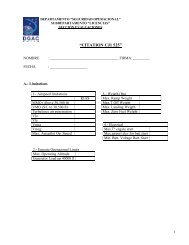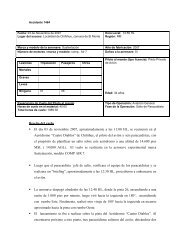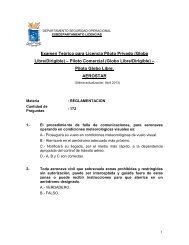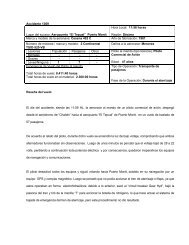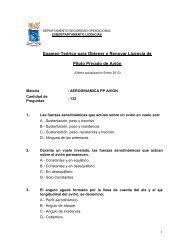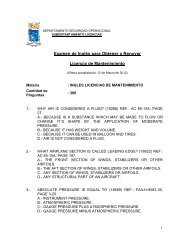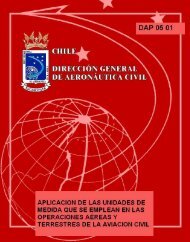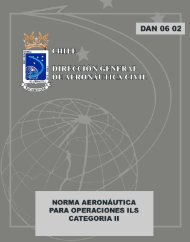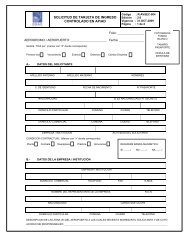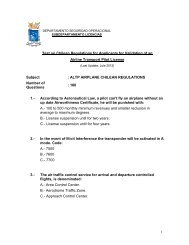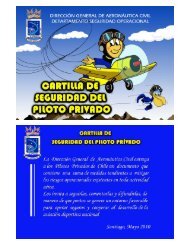EASA Safety Information Bulletin - DGAC
EASA Safety Information Bulletin - DGAC
EASA Safety Information Bulletin - DGAC
Create successful ePaper yourself
Turn your PDF publications into a flip-book with our unique Google optimized e-Paper software.
<strong>EASA</strong> SIB No: 2011-18<strong>EASA</strong> <strong>Safety</strong> <strong>Information</strong> <strong>Bulletin</strong>SIB No.: 2011-18Issued: 15 June 2011Subject: Techtest Ltd. Emergency Locator Transmitter (ELT) –Marking and Training ConsiderationsApplicability:All aircraft, certificated in any category, that have a TechtestLtd. (also known as HR Smith) Type 500-12, 500-16, or 500-27ELT installed as required equipment, or carried onboard byindividuals.Note 1: These Techtest Type 500 devices may be classified as either an ELT-S (Survival) ora Personal Locator Beacon (PLB)Note 2: Use of acronyms in this SIB: ELT – An Aviation Authority approved EmergencyLocator Transmitter carried to comply with aircraft operational requirements (e.g. JAR OPS3.820 and 3.830, EU OPS 1.820, 1.830, 1.835). PLB – A personal locator device used forpurposes other than to comply with (aircraft) operational requirements.Description:Following an accident and a subsequent search and rescueoperation in the North Sea, it became evident that the users ofthe affected portable/survival ELTs may not have had sufficientknowledge about the intended operation in general and of thespecific functions of the units.The Techtest type 500 device provides an additional ‘multiplebeacon’ feature that is activated as long as a sufficiently strongsignal is received on a frequency of 121.5 Megahertz (MHz) or243 MHz. This is sometimes referred to as ‘SMARTfunctionality’. This function is intended to avoid multiple targetsfor the homing operation. When a 121.5/243 MHz transmissionfrom any other source with a certain signal level is detected,the location signal transmission on 121.5/243 MHz issuspended and no own homing signal is broadcasted underthat condition. However, the received signal swept tone or thereceived voice transmission is heard in the loudspeakerinstead of monitoring the own transmission.In the accident case, a weak signal from a nearby PLB wassufficient to cause the Techtest Type 500 devices to go into‘multiple beacon’ mode and to suppress their 121.5/243 MHztransmissions. This weak active transmitted signal meant thatthe rescue vessel had difficulty in locating the survivors, as thesignal from that PLB was too weak to ensure the homingfunction, yet strong enough to suspend the transmission of theTechtest Type 500 device. This behaviour delayed the rescueThis is information only. Recommendations are not mandatory.<strong>EASA</strong> Form 117 Page 1/2
<strong>EASA</strong> SIB No: 2011-18operation and could have resulted in an inability to locate andrescue the survivors.The same technical functionality is used to implement theautomatic voice reception function. It should be noted that thisimplementation of the ‘multiple beacon’/automatic voicereception function does not meet the current <strong>EASA</strong>interpretation of the specific CS-ETSO requirements foroptional voice capability.Recommendations: Marking: The antenna should be turned into an uprightposition and extended for proper operation. Further, the usershould take care that the antenna is out of the water to allowproper radiation of the signal.If the antenna extension action is not already placarded and/ordescribed on the unit – which is the case for unitsmanufactured before mid 2009 – a suitable placard should beinstalled on the unit.Training: Operators should ensure that all potential users ofthe ELT units are familiar with the specific functions of the ELTand are provided with appropriate training, including recurrenttraining at suitable intervals.The following should be specifically addressed:Automatic receiving functionality: To correctly understand theoperating status of the ELT (broadcast transmissions versusthe ‘multiple beacon’ receive only mode) the user shouldunderstand and be able to distinguish between the receivedtransmissions from other devices near by and his owntransmissions. This can be determined by the tones heard incombination with the indicator lamp status. As the behaviour ofthe unit is quite similar, it will likely be misinterpreted. Refer tothe last revision of the Operating Manual for further details.The voice function is in general only used in the militaryenvironment. Consequently, the rescue team will not expectsuch function and will not consider its availability. The ‘multiplebeacon’ feature will not be expected at all.Care should be taken when demonstrating the use of the unitsto avoid erroneous alarms.Contacts:For any question concerning the technical content of therecommended actions in this SIB, please contact:Techtest Ltd., Quality Assurance Department,Street Court, Kingsland, Leominster, Herefordshire HR6 9QA,United Kingdom, E-mail quality@hr-smith.com;website www.hr-smith.comFor further information, contact the Airworthiness Directives,<strong>Safety</strong> Management & Research Section, CertificationDirectorate, <strong>EASA</strong>. E-mail: ADs@easa.europa.eu.This is information only. Recommendations are not mandatory.<strong>EASA</strong> Form 117 Page 2/2



